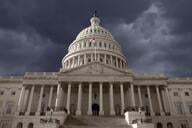You have /5 articles left.
Sign up for a free account or log in.
In 2020, we in America have the opportunity to add 12 million new voters to the electorate and shape voter turnout patterns for generations to come. In U.S. elections, most eligible Americans don’t vote. In fact, in every presidential race since 1790, the number of people not voting has been larger than the number of votes cast for the winning candidate.
But new research suggests voter engagement is rising, especially among young people at colleges and universities. That rise marks a huge opportunity for our democracy, since their generation will soon be the largest in America. Given the habitual nature of voting, we now have the chance to shape their voting patterns (and hence our politics) for decades -- if institutions of higher education take advantage of the moment.
Research from the Institute for Democracy and Higher Education recently showed a significant surge in college student voting. In 2018, voting for all Americans went up by 11 percent compared to the previous midterm election in 2014. But the rise among college students, as measured by a study that includes over 1,000 colleges and universities, was an impressive 21 percent. (Hispanic students saw the highest increase, from 14 percent in 2014 to 36.5 percent in 2016 -- a jump of 22.5 percent.) The study’s authors estimate that, overall, 7.5 million college students voted in 2018.
As a political scientist who studies how institutions like colleges and universities can get people civically involved, I’ve documented two approaches such institutions need to take to build on this momentum and expand gains in voting. Successful organizations mobilize (that is, they get lots and lots of people to participate) and organize (they give those participants opportunities to develop leadership, relationships and skills).
The smartest organizations mobilize when opportunities are ripe, such as moments like now. According to polls, interest in the 2020 election is extraordinarily high. That could give us an opportunity for a level of national civic engagement we have rarely seen.
Registering college-age students to vote is a great opportunity for mobilization. Nearly 20 million Americans attend college. Because of their age, relatively few of them have voted before, and many are not registered to vote. Recent case studies show that colleges that undertake campus voter-registration campaigns can register nearly all of them. Northwestern University, for example, has registered more than 90 percent of eligible students. A program at the State University of New York at Stony Brook targeting first-year students registered 99.2 percent of eligible voters. What’s more, voting is habitual. By mobilizing Generation Z voters now, we can turn those young people into lifelong voters.
In addition, campuses can use this opportunity not only to increase turnout but also to do so in a way that helps develop the larger muscle systems students need for democracy. A large body of research reveals evidence-based best practices for getting students to vote -- like creating a universitywide plan to register and empower every student, and holding a community celebration on Election Day. In addition, colleges and universities can draw on a key lesson we have learned from other get-out-the-vote studies: social relationships and peer-to-peer outreach can be the most effective way to get people to turn out. Campuses can identify, train and develop student leaders to be ambassadors of democracy and voting on their campuses.
This work of identifying, developing and creating community around student leaders is the work of organizing -- and part of the responsibility colleges and universities have to develop engaged, deliberative citizens.
Colleges and universities are also distinctly positioned to educate young people in nonpartisan ways and empower them to make judgments about candidates and issues. They can help students learn to collaborate across differences of race, gender identity and sexual orientation, ethnic background and nation of origin, political affiliation, urban/rural divides, and economic background. College classes can challenge students to put together information from multiple sources and judge various forms of evidence. They can also teach them to analyze social problems, consider possible solutions and take action. They can model ways that Americans can debate issues passionately while tolerating alternative points of view.
Perhaps most important, colleges can empower students with tools and inspirations drawn from history, including the lesson that one of the best ways to make change is to join together with others through community groups, grassroots organizations, business groups or political parties. Voting, and developing student ambassadors, in other words, can be a gateway to something much bigger.
This work will not be easy or quick. It is a complicated and long-term project. And that is all the more reason to begin now. American colleges and universities can empower students to vote and to participate in all the dimensions of citizenship that the nation requires -- if they seize the opportunity of this moment to rededicate themselves to the service of democracy. By doing so, higher education can help provide the nation with lifelong learners and citizens who will be active and informed participants in our democracy for years to come.




